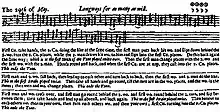All Things Bright and Beautiful
"All Things Bright and Beautiful" is an Anglican hymn, also sung in many other Christian denominations. The words are by Cecil Frances Alexander and were first published in her Hymns for Little Children.
| All Things Bright and Beautiful | |
|---|---|
| Genre | Hymn |
| Written | 1848 |
| Text | Cecil Frances Alexander |
| Meter | 7.6.7.6 with refrain |
| Melody | "The 29th of May" from The Dancing Master by John Playford (Seventh Edition – 1686) |
The melody originated from the 17th-century English country dance tune "The 29th of May."[1] This was later adapted by Martin Shaw and William Henry Monk. There have also been other adaptations, such as a full choral piece by John Rutter. In earlier editions of the Church of Scotland's Church Hymnary, the tunes "God in Nature" by John Stainer and "All Things Bright" by Frederick Arthur Gore Ouseley had been used. The chorus has been recommended as a Christian song for children to learn, even for children as young as five years of age.[2]
History
The hymn was first published in 1848 in Mrs Cecil Alexander's Hymns for Little Children. It consists of a series of stanzas that elaborate upon verses of the Apostles' Creed. It may have been inspired by Psalm 104, verses 24 and 25: "Oh Lord, how manifold are thy works! in wisdom hast thou made them all: the earth is full of thy riches. So is this great and wide sea, wherein are things creeping innumerable, both small and great beasts". The hymn may have been inspired as well by a verse from Samuel Taylor Coleridge's The Rime of the Ancient Mariner: "He prayeth best, who loveth best; All things great and small; For the dear God who loveth us; He made and loveth all." Alternatively, inspiration may have come from William Paley's Natural Theology, published in 1802, that argues for God as the designer of the natural world. For example, the hymn's second verse alludes to "wings" and verse 7 refers to "eyes". Paley cited wings and eyes as examples of complexity of design, analogous to that of a watch, with God as the Divine Watchmaker.
Alexander's composition of the hymn's text has been attributed to four locations: Llanwenarth House in Govilon, Monmouthshire – the refrain "The purple headed mountains, The river running by" possibly referring to the Sugar Loaf and Blorenge mountains and to the River Usk; Markree Castle near Sligo, and Minehead and the nearby village of Dunster in 1848, in which case the "purple headed mountain" might refer to Grabbist Hill and the river to the River Avill.[3] However, a more credible account is given by Sir John Heygate of Bellarena House in County Londonderry, which links the hymn to the many visits paid by the Alexanders to what was then the Gage family residence, a family into which Sir John's ancestor -Sir Frederick Heygate-married in 1850. Writing in 1973, Sir John attributed "the purple headed mountain" to nearby Benevenagh, and "the river running by" to the River Roe which flows past Bellerena House. Sir John had heard the story from the late Sir Norman Stronge, speaker of the Northern Ireland House of Commons, whose family also had ties to the area.
Words
Alexander's text reads:[4]
1.
All things bright and beautiful,
All creatures great and small,
All things wise and wonderful,
The Lord God made them all.
2.
Each little flower that opens,
Each little bird that sings,
He made their glowing colours,
He made their tiny wings.
All things bright ...
3.
The rich man in his castle,
The poor man at his gate,
God made them, high and lowly,
And ordered their estate.
All things bright ...
4.
The purple headed mountain,
The river running by,
The sunset and the morning,
That brightens up the sky;−
All things bright ...
5.
The cold wind in the winter,
The pleasant summer sun,
The ripe fruits in the garden,−
He made them every one:
All things bright ...
6.
The tall trees in the greenwood,
The meadows where we play,
The rushes by the water,
We gather every day;−
All things bright ...
7.
He gave us eyes to see them,
And lips that we might tell,
How great is God Almighty,
Who has made all things well.
All things bright ...
(Amen)
Many later versions and performances of the hymn omit the third verse.[5][6][7] The United Church of Canada includes a fourth verse: "The rocky mountain splendour, / the lone wolf's haunting call, / the Great Lakes and the prairies, / the forest in the fall."[8]
References
- The Dancing Master by John Playford (1686). "The Twenty-Ninth of May" – via YouTube.
- The Power to Comprehend with All the Saints: The Formation and Practice of a Pastor-Theologian, edited by Wallace M. Alston Jr., Cynthia A. Jarvis, page 44, from the chapter entitled "Raising Pastor-Theologians" by Brant S. Copeland
- "Avill Valley". Everything Exmoor. Retrieved 12 September 2014.
- Hymns Ancient and Modern (Second Edition – 1875)
- http://www.hymntime.com/tch/htm/a/l/l/allthing.htm Archived 3 July 2011 at the Wayback Machine
- "Oremus Hymnal: All things bright and beautiful". Oremus.org. Archived from the original on 22 July 2011. Retrieved 2 September 2011.
- Archived 1 April 2007 at the Wayback Machine
- Voices United: The Hymn and Worship Book of the United Church of Canada, (Toronto: The United Church Publishing House, c. 1996), #291